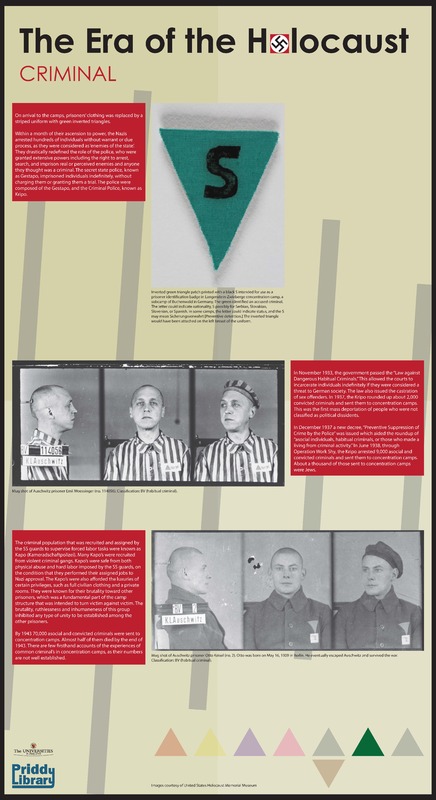Criminal Prisoners
On arrival to the camps, prisoners’ clothing was replaced by a
striped uniform with green inverted triangles.
Within a month of their ascension to power, the Nazis
arrested hundreds of individuals without warrant or due
process, as they were considered as ‘enemies of the state’.
They drastically redefined the role of the police, who were
granted extensive powers including the right to arrest,
search, and imprison real or perceived enemies and anyone
they thought was a criminal. The secret state police, known
as Gestapo, imprisoned individuals indefinitely, without
charging them or granting them a trial. The police were
composed of the Gestapo, and the Criminal Police, known as
Kripo.
In November 1933, the government passed the “Law against
Dangerous Habitual Criminals.” This allowed the courts to
incarcerate individuals indefinitely if they were considered a
threat to German society. The law also issued the castration
of sex offenders. In 1937, the Kripo rounded up about 2,000
convicted criminals and sent them to concentration camps.
This was the first mass deportation of people who were not
classied as political dissidents.
In December 1937 a new decree, “Preventive Suppression of
Crime by the Police” was issued which aided the roundup of
“asocial individuals, habitual criminals, or those who made a
living from criminal activity.” In June 1938, through
Operation Work Shy, the Kripo arrested 9,000 asocial and
convicted criminals and sent them to concentration camps.
About a thousand of those sent to concentration camps
were Jews.
The criminal population that was recruited and assigned by
the SS guards to supervise forced labor tasks were known as
Kapo (Kameradschaftpolizei). Many Kapo’s were recruited
from violent criminal gangs. Kapo’s were safe from both
physical abuse and hard labor imposed by the SS guards, on
the condition that they performed their assigned jobs to
Nazi approval. The Kapo’s were also afforded the luxuries of
certain privileges, such as full civilian clothing and a private
rooms. They were known for their brutality toward other
prisoners, which was a fundamental part of the camp
structure that was intended to turn victim against victim. The
brutality, ruthlessness and inhumaneness of this group
inhibited any type of unity to be established among the
other prisoners.
By 1943 70,000 asocial and convicted criminals were sent to
concentration camps. Almost half of them died by the end of
1943. There are few firsthand accounts of the experiences of
common criminal’s in concentration camps, as their numbers
are not well established.
